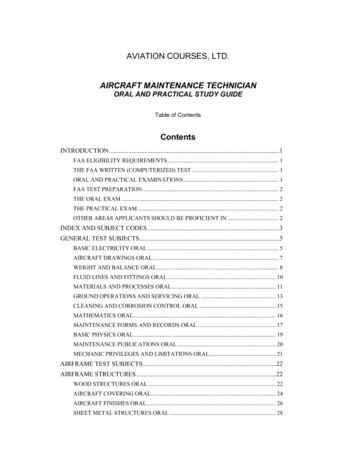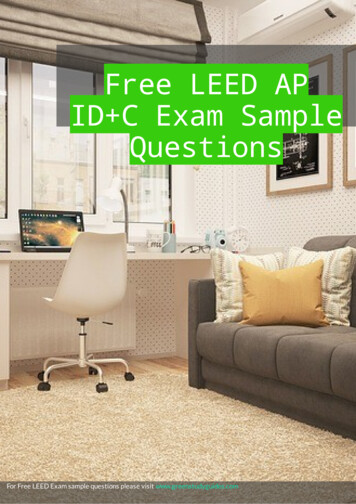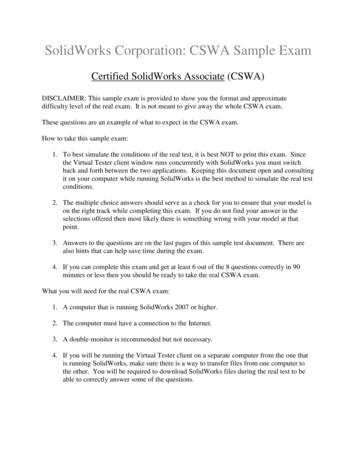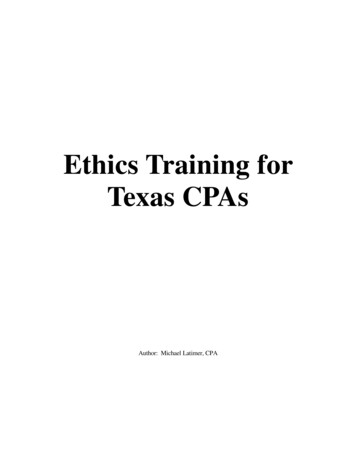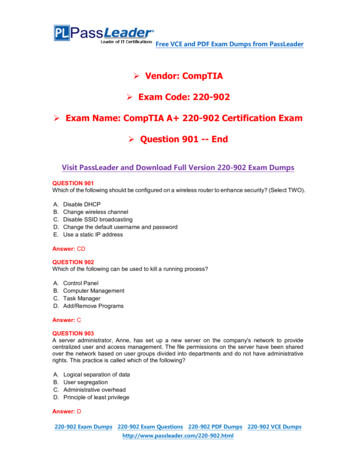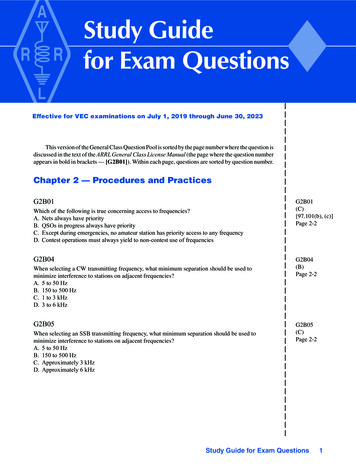
Transcription
Study Guidefor Exam QuestionsEffective for VEC examinations on July 1, 2019 through June 30, 2023This version of the General Class Question Pool is sorted by the page number where the question isdiscussed in the text of the ARRL General Class License Manual (the page where the question numberappears in bold in brackets — [G2B01]). Within each page, questions are sorted by question number.Chapter 2 — Procedures and PracticesG2B01Which of the following is true concerning access to frequencies?A. Nets always have priorityB. QSOs in progress always have priorityC. Except during emergencies, no amateur station has priority access to any frequencyD. Contest operations must always yield to non-contest use of frequenciesG2B04When selecting a CW transmitting frequency, what minimum separation should be used tominimize interference to stations on adjacent frequencies?A. 5 to 50 HzB. 150 to 500 HzC. 1 to 3 kHzD. 3 to 6 kHzG2B05When selecting an SSB transmitting frequency, what minimum separation should be used tominimize interference to stations on adjacent frequencies?A. 5 to 50 HzB. 150 to 500 HzC. Approximately 3 kHzD. Approximately 6 kHzG2B01(C)[97.101(b), (c)]Page 2-2G2B04(B)Page 2-2G2B05(C)Page 2-2Study Guide for Exam Questions 1
G2B06(A)Page 2-2G2B06G2B07(C)Page 2-2G2B07G2C04(D)Page 2-2G2D07(D)Page 2-2What is a practical way to avoid harmful interference on an apparently clear frequency beforecalling CQ on CW or phone?A. Send “QRL?” on CW, followed by your call sign; or, if using phone, ask if the frequency is inuse, followed by your call signB. Listen for 2 minutes before calling CQC. Send the letter “V” in Morse code several times and listen for a response, or say “test” severaltimes and listen for a responseD. Send “QSY” on CW or if using phone, announce “the frequency is in use,” then give your callsign and listen for a responseWhich of the following complies with good amateur practice when choosing a frequency on whichto initiate a call?A. Check to see if the channel is assigned to another stationB. Identify your station by transmitting your call sign at least 3 timesC. Follow the voluntary band plan for the operating mode you intend to useD. All these choices are correctG2C04What does the Q signal “QRL?” mean?A. “Will you keep the frequency clear?”B. “Are you operating full break-in?” or “Can you operate full break-in?”C. “Are you listening only for a specific station?”D. “Are you busy?” or “Is this frequency in use?”G2D07Which of the following are examples of the NATO Phonetic Alphabet?A. Able, Baker, Charlie, DogB. Adam, Boy, Charles, DavidC. America, Boston, Canada, DenmarkD. Alpha, Bravo, Charlie, DeltaG1B08(D)[97.101(a)]Page 2-4G1B08G2B03(C)Page 2-4G2B03When choosing a transmitting frequency, what should you do to comply with good amateurpractice?A. Ensure that the frequency and mode selected are within your license class privilegesB. Follow generally accepted band plans agreed to by the Amateur Radio communityC. Monitor the frequency before transmittingD. All these choices are correctWhat is good amateur practice if propagation changes during a contact and you notice interferencefrom other stations on the frequency?A. Tell the interfering stations to change frequencyB. Report the interference to your local Amateur Auxiliary CoordinatorC. Attempt to resolve the interference problem with the other stations in a mutually acceptablemannerD. Increase power to overcome interference2 Study Guide for Exam Questions
G4A03What is normally meant by operating a transceiver in “split” mode?A. The radio is operating at half powerB. The transceiver is operating from an external power sourceC. The transceiver is set to different transmit and receive frequenciesD. The transmitter is emitting an SSB signal, as opposed to DSB operationG4A12Which of the following is a common use for the dual-VFO feature on a transceiver?A. To allow transmitting on two frequencies at onceB. To permit full duplex operation — that is, transmitting and receiving at the same timeC. To permit monitoring of two different frequenciesD. To facilitate computer interfaceG2A08G4A03(C)Page 2-4G4A12(C)Page 2-4G2A08(B)Page 2-5What is the recommended way to break in to a phone contact?A. Say “QRZ” several times, followed by your call signB. Say your call sign onceC. Say “Breaker Breaker”D. Say “CQ” followed by the call sign of either stationG2A11Generally, who should respond to a station in the contiguous 48 states who calls “CQ DX”?A. Any caller is welcome to respondB. Only stations in GermanyC. Any stations outside the lower 48 statesD. Only contest stationsG2B08What is the voluntary band plan restriction for U.S. stations transmitting within the 48 contiguousstates in the 50.1 to 50.125 MHz band segment?A. Only contacts with stations not within the 48 contiguous statesB. Only contacts with other stations within the 48 contiguous statesC. Only digital contactsD. Only SSTV contactsG2D05Which of the following is a good way to indicate on a clear frequency in the HF phone bands thatyou are looking for a contact with any station?A. Sign your call sign once, followed by the words “listening for a call” -- if no answer, changefrequency and repeatB. Say “QTC” followed by “this is” and your call sign -- if no answer, change frequency andrepeatC. Repeat “CQ” a few times, followed by “this is,” then your call sign a few times, then pause tolisten, repeat as necessaryD. Transmit an unmodulated carried for approximately 10 seconds, followed by “this is” and yourcall sign, and pause to listen -- repeat as necessaryG2A11(C)Page 2-5G2B08(A)Page 2-5G2D05(C)Page 2-5Study Guide for Exam Questions 3
G2D09(C)Page 2-5G2D09G1C12(A)[97.303(i)]Page 2-6G1C12G2D08(D)Page 2-6G2D08G2A01(A)Page 2-9G2A01G2A02(B)Page 2-9G2A02G2A03(A)Page 2-9G2A03Which of the following is required when participating in a contest on HF frequencies?A. Submit a log to the contest sponsorB. Send a QSL card to the stations worked, or QSL via Logbook of The WorldC. Identify your station per normal FCC regulationsD. All these choices are correctWhich of the following is required by the FCC rules when operating in the 60-meter band?A. If you are using an antenna other than a dipole, you must keep a record of the gain of yourantennaB. You must keep a record of the date, time, frequency, power level, and stations workedC. You must keep a record of all third-party trafficD. You must keep a record of the manufacturer of your equipment and the antenna usedWhat is a reason why many amateurs keep a station log?A. The ITU requires a log of all international contactsB. The ITU requires a log of all international third-party trafficC. The log provides evidence of operation needed to renew a license without retestD. To help with a reply if the FCC requests informationWhich sideband is most commonly used for voice communications on frequencies of 14 MHz orhigher?A. Upper sidebandB. Lower sidebandC. Vestigial sidebandD. Double sidebandWhich of the following modes is most commonly used for voice communications on the160-meter, 75-meter, and 40-meter bands?A. Upper sidebandB. Lower sidebandC. Vestigial sidebandD. Double sidebandWhich of the following is most commonly used for SSB voice communications in the VHF andUHF bands?A. Upper sidebandB. Lower sidebandC. Vestigial sidebandD. Double sideband4 Study Guide for Exam Questions
G2A04Which mode is most commonly used for voice communications on the 17-meter and 12-meterbands?A. Upper sidebandB. Lower sidebandC. Vestigial sidebandD. Double sidebandG2A05Which mode of voice communication is most commonly used on the HF amateur bands?A. Frequency modulationB. Double sidebandC. Single sidebandD. Phase modulationG2A06Which of the following is an advantage when using single sideband, as compared to other analogvoice modes on the HF amateur bands?A. Very high fidelity voice modulationB. Less subject to interference from atmospheric static crashesC. Ease of tuning on receive and immunity to impulse noiseD. Less bandwidth used and greater power efficiencyG2A07Which of the following statements is true of the single sideband voice mode?A. Only one sideband and the carrier are transmitted; the other sideband is suppressedB. Only one sideband is transmitted; the other sideband and carrier are suppressedC. SSB is the only voice mode that is authorized on the 20-meter, 15-meter, and 10-meter amateurbandsD. SSB is the only voice mode that is authorized on the 160-meter, 75-meter, and 40-meteramateur bandsG2A09Why do most amateur stations use lower sideband on the 160-meter, 75-meter, and 40-meterbands?A. Lower sideband is more efficient than upper sideband at these frequenciesB. Lower sideband is the only sideband legal on these frequency bandsC. Because it is fully compatible with an AM detectorD. It is good amateur practiceG2C07When sending CW, what does a “C” mean when added to the RST report?A. Chirpy or unstable signalB. Report was read from an S meter rather than estimatedC. 100 percent copyD. Key clicksG2A04(A)Page 2-9G2A05(C)Page 2-9G2A06(D)Page 2-9G2A07(B)Page 2-9G2A09(D)Page 2-9G2C07(A)Page 2-11Study Guide for Exam Questions 5
G2C10(D)Page 2-11G2C10G2A10(B)Page 2-12G2A10G2C01(D)Page 2-13G2C01G2C02(A)Page 2-13G2C02G2C03(C)Page 2-13What does the Q signal “QRN” mean?A. Send more slowlyB. Stop sendingC. Zero beat my signalD. I am troubled by staticWhich of the following statements is true of voice VOX operation versus PTT operation?A. The received signal is more natural soundingB. It allows “hands free” operationC. It occupies less bandwidthD. It provides more power outputWhich of the following describes full break-in telegraphy (QSK)?A. Breaking stations send the Morse code prosign “BK”B. Automatic keyers, instead of hand keys, are used to send Morse codeC. An operator must activate a manual send/receive switch before and after every transmissionD. Transmitting stations can receive between code characters and elementsWhat should you do if a CW station sends “QRS?”A. Send slowerB. Change frequencyC. Increase your powerD. Repeat everything twiceG2C03What does it mean when a CW operator sends “KN” at the end of a transmission?A. Listening for novice stationsB. Operating full break-inC. Listening only for a specific station or stationsD. Closing station nowG2C05(B)Page 2-13G2C05G2C06(D)Page 2-13G2C06What is the best speed to use when answering a CQ in Morse code?A. The fastest speed at which you are comfortable copying, but no slower than the CQB. The fastest speed at which you are comfortable copying, but no faster than the CQC. At the standard calling speed of 10 wpmD. At the standard calling speed of 5 wpmWhat does the term “zero beat” mean in CW operation?A. Matching the speed of the transmitting stationB. Operating split to avoid interference on frequencyC. Sending without errorD. Matching the transmit frequency to the frequency of a received signal6 Study Guide for Exam Questions
G2C08What prosign is sent to indicate the end of a formal message when using CW?A. SKB. BKC. ARD. KNG2C09G2C08(C)Page 2-13G2C09(C)Page 2-13What does the Q signal “QSL” mean?A. Send slowerB. We have already confirmed by cardC. I acknowledge receiptD. We have worked beforeG2C11G2C11(D)Page 2-13What does the Q signal “QRV” mean?A. You are sending too fastB. There is interference on the frequencyC. I am quitting for the dayD. I am ready to receive messagesG4A10What is the purpose of an electronic keyer?A. Automatic transmit/receive switchingB. Automatic generation of strings of dots and dashes for CW operationC. VOX operationD. Computer interface for PSK and RTTY operationG2B09Who may be the control operator of an amateur station transmitting in RACES to assist reliefoperations during a disaster?A. Only a person holding an FCC-issued amateur operator licenseB. Only a RACES net control operatorC. A person holding an FCC-issued amateur operator license or an appropriate government officialD. Any control operator when normal communication systems are operationalG2B02What is the first thing you should do if you are communicating with another amateur station andhear a station in distress break in?A. Continue your communication because you were on the frequency firstB. Acknowledge the station in distress and determine what assistance may be neededC. Change to a different frequencyD. Immediately cease all transmissionsG2B10When is an amateur station allowed to use any means at its disposal to assist another station in distress?A. Only when transmitting in RACESB. At any time when transmitting in an organized netC. At any time during an actual emergencyD. Only on authorized HF frequenciesG4A10(B)Page 2-13G2B09(A)[97.407(a)]Page 2-17G2B02(B)Page 2-18G2B10(C)[97.405(b)]Page 2-18Study Guide for Exam Questions 7
G2B11(A)[97.405]Page 2-18G2B11What frequency should be used to send a distress call?A. Whichever frequency has the best chance of communicating the distress messageB. Only frequencies authorized for RACES or ARES stationsC. Only frequencies that are within your operating privilegesD. Only frequencies used by police, fire, or emergency medical servicesChapter 3 — Rules and RegulationsG1A14(D)[97.301(d)]Page 3-2G1A14G1E06(C)[97.301,ITU RadioRegulations]Page 3-2G1E06G2D02(B)Page 3-2G2D02G1B01(C)[97.15(a)]Page 3-3G1B01G1B06(D)[97.15(b),PRB-1, 101FCC 2d 952(1985)]Page 3-3G1B06Which of the following may apply in areas under FCC jurisdiction outside of ITU Region 2?A. Station identification may have to be in a language other than EnglishB. Morse code may not be permittedC. Digital transmission may not be permittedD. Frequency allocations may differThe frequency allocations of which ITU region apply to radio amateurs operating in North andSouth America?A. Region 4B. Region 3C. Region 2D. Region 1Which of the following are objectives of the Volunteer Monitoring Program?A. To conduct efficient and orderly amateur licensing examinationsB. To encourage amateur radio operators to self-regulate and comply with the rulesC. To coordinate repeaters for efficient and orderly spectrum usageD. To provide emergency and public safety communicationsWhat is the maximum height above ground to which an antenna structure may be erected withoutrequiring notification to the FAA and registration with the FCC, provided it is not at or near apublic use airport?A. 50 feetB. 100 feetC. 200 feetD. 300 feetUnder what conditions are state and local governments permitted to regulate Amateur Radioantenna structures?A. Under no circumstances, FCC rules take priorityB. At any time and to any extent necessary to accomplish a legitimate purpose of the state or localentity, provided that proper filings are made with the FCCC. Only when such structures exceed 50 feet in height and are clearly visible 1000 feet from thestructureD. Amateur Service communications must be reasonably accommodated, and regulations mustconstitute the minimum practical to accommodate a legitimate purpose of the state or local entity8 Study Guide for Exam Questions
G2D01What is the Volunteer Monitoring Program?A. Amateur volunteers who are formally enlisted to monitor the airwaves for rules violationsB. Amateur volunteers who conduct amateur licensing examinationsC. Amateur volunteers who conduct frequency coordination for amateur VHF repeatersD. Amateur volunteers who use their station equipment to help civil defense organizations in timesof emergencyG2D03What skills learned during hidden transmitter hunts are of help to the Volunteer MonitoringProgram?A. Identification of out-of-band operationB. Direction finding used to locate stations violating FCC rulesC. Identification of different call signsD. Hunters have an opportunity to transmit on non-amateur frequenciesG1D02What license examinations may you administer when you are an accredited VE holding a Generalclass operator license?A. General and TechnicianB. General onlyC. Technician onlyD. Amateur Extra, General, and TechnicianG1D04Which of the following is a requirement for administering a Technician class license examination?A. At least three General class or higher VEs must observe the examinationB. At least two General class or higher VEs must be presentC. At least two General class or higher VEs must be present, but only one need be Amateur ExtraclassD. At least three VEs of Technician class or higher must observe the examinationG1D05Which of the following must a person have before they can be an administering VE for aTechnician class license examination?A. Notification to the FCC that you want to give an examinationB. Receipt of a Certificate of Successful Completion of Examination (CSCE) for General classC. Possession of a properly obtained telegraphy licenseD. An FCC General class or higher license and VEC accreditationG1D07Volunteer Examiners are accredited by what organization?A. The Federal Communications CommissionB. The Universal Licensing SystemC. A Volunteer Examiner CoordinatorD. The Wireless Telecommunications BureauG2D01(A)Page 3-3G2D03(B)Page 3-3G1D02(C)[97.509(b)(3)(i)]Page 3-4G1D04(A)[97.509(3)(i)(c)]Page 3-4G1D05(D)[97.509(b)(3)(i)]Page 3-4G1D07(C)[97.509(b)(1)]Page 3-4Study Guide for Exam Questions 9
G1D08(B)[97.509(b)(3)]Page 3-4G1D09(C)[97.9(b)]Page 3-4G1D10(B)[97.509(b)(2)]Page 3-4G1D01(A)[97.501,97.505(a)]Page 3-5G1D08Which of the following criteria must be met for a non-U.S. citizen to be an accredited VolunteerExaminer?A. The person must be a resident of the U.S. for a minimum of 5 yearsB. The person must hold an FCC granted Amateur Radio license of General class or aboveC. The person’s home citizenship must be in ITU region 2D. None of these choices is correct; a non-U.S. citizen cannot be a Volunteer ExaminerG1D09How long is a Certificate of Successful Completion of Examination (CSCE) valid for examelement credit?A. 30 daysB. 180 daysC. 365 daysD. For as long as your current license is validG1D10What is the minimum age that one must be to qualify as an accredited Volunteer Examiner?A. 12 yearsB. 18 yearsC. 21 yearsD. There is no age limitG1D01Who may receive partial credit for the elements represented by an expired Amateur Radio license?A. Any person who can demonstrate that they once held an FCC-issued General, Advanced, orAmateur Extra class license that was not revoked by the FCCB. Anyone who held an FCC-issued Amateur Radio license that has been expired for not less than5 years and not more than 15 yearsC. Any person who previously held an amateur license issued by another country, but only if thatcountry has a current reciprocal licensing agreement with the FCCD. Only persons who once held an FCC issued Novice, Technician, or Technician Plus licenseG1D03(C)[97.9(b)]Page 3-5G1D03G1D06(A)[97.119(f)(2)]Page 3-5G1D06On which of the following band segments may you operate if you are a Technician class operatorand have a Certificate of Successful Completion of Examination (CSCE) for General classprivileges?A. Only the Technician band segments until your upgrade is posted in the FCC databaseB. Only on the Technician band segments until your license arrives in the mailC. On any General or Technician class band segmentD. On any General or Technician class band segment except 30 meters and 60 metersWhen must you add the special identifier “AG” after your call sign if you are a Technician classlicensee and have a Certificate of Successful Completion of Examination (CSCE) for General classoperator privileges, but the FCC has not yet posted your upgrade on its website?A. Whenever you operate using General class frequency privilegesB. Whenever you operate on any amateur frequencyC. Whenever you operate using Technician frequency privilegesD. A special identifier is not required if your General class license application has been filed withthe FCC10 Study Guide for Exam Questions
G1D11What is required to obtain a new General Class license after a previously-held license has expiredand the two-year grace period has passed?A. They must have a letter from the FCC showing they once held an amateur or commerciallicenseB. There are no requirements other than being able to show a copy of the expired licenseC. The applicant must be able to produce a copy of a page from a call book published in the U.S.showing his or her name and addressD. The applicant must pass the current Element 2 examG1A01On which HF/MF bands is a General class license holder granted all amateur frequency privileges?A. 60 meters, 20 meters, 17 meters, and 12 metersB. 160 meters, 80 meters, 40 meters, and 10 metersC. 160 meters, 60 meters, 30 meters, 17 meters, 12 meters, and 10 metersD. 160 meters, 30 meters, 17 meters, 15 meters, 12 meters, and 10 metersG1A02G1D11(D)[97.505]Page 3-5G1A01(C)[97.301(d)]Page 3-8G1A02(B)[97.305]Page 3-8On which of the following bands is phone operation prohibited?A. 160 metersB. 30 metersC. 17 metersD. 12 metersG1A03G1A03(B)[97.305]Page 3-8On which of the following bands is image transmission prohibited?A. 160 metersB. 30 metersC. 20 metersD. 12 metersG1A04Which of the following amateur bands is restricted to communication only on specific channels,rather than frequency ranges?A. 11 metersB. 12 metersC. 30 metersD. 60 metersG1A05Which of the following frequencies is in the General class portion of the 40-meter band (in ITURegion 2)?A. 7.250 MHzB. 7.500 MHzC. 40.200 MHzD. 40.500 MHzG1A04(D)[97.303 (h)]Page 3-8G1A05(A)[97.301(d)]Page 3-8Study Guide for Exam Questions 11
G1A06(C)[97.301(d)]Page 3-8G1A06G1A07(C)[97.301(d)]Page 3-8G1A07G1A08(C)[97.301(d)]Page 3-8G1A08G1A09(C)[97.301(d)]Page 3-8G1A09G1A10(D)[97.301(d)]Page 3-8G1A11(B)[97.301]Page 3-8Which of the following frequencies is within the General class portion of the 75-meter phoneband?A. 1875 kHzB. 3750 kHzC. 3900 kHzD. 4005 kHzWhich of the following frequencies is within the General class portion of the 20-meter phoneband?A. 14005 kHzB. 14105 kHzC. 14305 kHzD. 14405 kHzWhich of the following frequencies is within the General class portion of the 80-meter band?A. 1855 kHzB. 2560 kHzC. 3560 kHzD. 3650 kHzWhich of the following frequencies is within the General class portion of the 15-meter band?A. 14250 kHzB. 18155 kHzC. 21300 kHzD. 24900 kHzG1A10Which of the following frequencies is available to a control operator holding a General classlicense?A. 28.020 MHzB. 28.350 MHzC. 28.550 MHzD. All these choices are correctG1A11When General class licensees are not permitted to use the entire voice portion of a band, whichportion of the voice segment is generally available to them?A. The lower frequency endB. The upper frequency endC. The lower frequency end on frequencies below 7.3 MHz, and the upper end on frequenciesabove 14.150 MHzD. The upper frequency end on frequencies below 7.3 MHz, and the lower end on frequenciesabove 14.150 MHz12 Study Guide for Exam Questions
G1A12Which of the following applies when the FCC rules designate the Amateur Service as a secondaryuser on a band?A. Amateur stations must record the call sign of the primary service station before operating on afrequency assigned to that stationB. Amateur stations can use the band only during emergenciesC. Amateur stations can use the band only if they do not cause harmful interference to primaryusersD. Amateur stations may only operate during specific hours of the day, while primary users arepermitted 24- hour use of the bandG1A13What is the appropriate action if, when operating on either the 30-meter or 60-meter bands, astation in the primary service interferes with your contact?A. Notify the FCCs regional Engineer in Charge of the interferenceB. Increase your transmitter’s power to overcome the interferenceC. Attempt to contact the station and request that it stop the interferenceD. Move to a clear frequency or stop transmittingG1A15G1A12(C)[97.303]Page 3-8G1A13(D)[97.303(5)(h)(2)(j)]Page 3-8G1A15(D)[97.205(b)]Page 3-8What portion of the 10-meter band is available for repeater use?A. The entire bandB. The portion between 28.1 MHz and 28.2 MHzC. The portion between 28.3 MHz and 28.5 MHzD. The portion above 29.5 MHzG1E04Which of the following conditions require a licensed Amateur Radio operator to take specific stepsto avoid harmful interference to other users or facilities?A. When operating within one mile of an FCC Monitoring StationB. When using a band where the Amateur Service is secondaryC. When a station is transmitting spread spectrum emissionsD. All these choices are correctG1E07In what part of the 13-centimeter band may an amateur station communicate with non-licensedWi-Fi stations?A. Anywhere in the bandB. Channels 1 through 4C. Channels 42 through 45D. No partG8C01On what band do amateurs share channels with the unlicensed Wi-Fi service?A. 432 MHzB. 902 MHzC. 2.4 GHzD. 10.7 GHzG1E04(D)[97.13(b),97.303,97.311(b)]Page 3-8G1E07(D)[97.111]Page 3-8G8C01(C)Page 3-8Study Guide for Exam Questions 13
G1B02(D)[97.203(b)]Page 3-10G1B02G1B03(A)[97.3(a)(9)]Page 3-10G1B03G1B09(D)[97.203(d)]Page 3-10G1B09G1B10(C)[97.203(c)]Page 3-10G1B10G1E10(A)[97.101]Page 3-10G1E10G1E01(A)[97.115(b)(2)]Page 3-11With which of the following conditions must beacon stations comply?A. A beacon station may not use automatic controlB. The frequency must be coordinated with the National Beacon OrganizationC. The frequency must be posted on the internet or published in a national periodicalD. There must be no more than one beacon signal transmitting in the same band from the samestation locationWhich of the following is a purpose of a beacon station as identified in the FCC rules?A. Observation of propagation and receptionB. Automatic identification of repeatersC. Transmission of bulletins of general interest to Amateur Radio licenseesD. Identifying net frequenciesOn what HF frequencies are automatically controlled beacons permitted?A. On any frequency if power is less than 1 wattB. On any frequency if transmissions are in Morse codeC. 21.08 MHz to 21.09 MHzD. 28.20 MHz to 28.30 MHzWhat is the power limit for beacon stations?A. 10 watts PEP outputB. 20 watts PEP outputC. 100 watts PEP outputD. 200 watts PEP outputWhy should an amateur operator normally avoid transmitting on 14.100, 18.110, 21.150, 24. 930and 28.200 MHz?A. A system of propagation beacon stations operates on those frequenciesB. A system of automatic digital stations operates on those frequenciesC. These frequencies are set aside for emergency operationsD. These frequencies are set aside for bulletins from the FCCG1E01Which of the following would disqualify a third party from participating in stating a message overan amateur station?A. The third party’s amateur license has been revoked and not reinstatedB. The third party is not a U.S. citizenC. The third party is a licensed amateurD. The third party is speaking in a language other than English14 Study Guide for Exam Questions
G1E05What types of messages for a third party in another country may be transmitted by an amateurstation?A. Any message, as long as the amateur operator is not paidB. Only messages for other licensed amateursC. Only messages relating to Amateur Radio or remarks of a personal character, or messagesrelating to emergencies or disaster reliefD. Any messages, as long as the text of the message is recorded in the station logG1B04Which of the following transmissions is permitted?A. Unidentified transmissions for test purposes onlyB. Retransmission of other amateur station signals by any amateur stationC. Occasional retransmission of weather and propagation forecast information from U.S.government stationsD. Coded messages of any kind, if not intended to facilitate a criminal actG1B05Which of the following one-way transmissions are permitted?A. Unidentified test transmissions of less than one minute in durationB. Transmissions necessary to assist learning the International Morse codeC. Regular transmissions offering equipment for sale, if intended for Amateur Radio useD. All these choices are correctG1B07What are the restrictions on the use of abbreviations or procedural signals in the Amateur Service?A. Only “Q” signals are permittedB. They may be used if they do not obscure the meaning of a messageC. They are not permittedD. Only “10 codes” are permittedG1B12When is it permissible to communicate with amateur stations in countries outside the areasadministered by the Federal Communications Commission?A. Only when the foreign country has a formal third-party agreement filed with the FCCB. When the contact is with amateurs in any country except those whose administrations havenotified the ITU that they object to such communicationsC. When the contact is with amateurs in any country as long as the communication is conducted inEnglishD. Only when the foreign country is a member of the International Amateur Radio UnionG1E02When may a 10-meter repeater retransmit the 2-meter signal from a station that has a Technicianclass control operator?A. Under no circumstancesB. Only if the station on 10-meters is operating under a Special Temporary Authorization allowingsuch retransmissionC. Only during an FCC-declared general state of communications emergencyD. Only if the 10-meter repeater control operator holds at least a General class licenseG1E05(C)[97.115(a)(2),97.117]Page 3-11G1B04(C)[97.113(c)]Page 3-13G1B05(B)[97.111((5)(b)]Page 3-13G1B07(B)[97.113(a)(4)]Page 3-13G1B12(B)[97.111(a)(1)]Page 3-13G1E02(D)[97.205(b)]Page 3-13Study Guide for Exam Questions 15
G1B11(A)[97.101(a)]Page 3-14G1B11G1C02(C)[97.313]Page 3-14G1C02G1C06(D)[97.313]Page 3-14G1C06G1C15(D)[97.313]Page 3-14G1C15G2D10(B)Page 3-14G2D10G1C01(A)[97.313(c)(1)]Page 3-15G1C01G1C03(A)[97.303(h)(1)]Page 3-15Who or what determines “good engineering and good amateur practice,” as applied to the operationof an amateur station in all respects not covered by the Part 97 rules?A. The FCCB. The control operatorC. The IEEED. The ITUWhat is the maximum transmitting power an amateur station may use on the 12-meter band?A. 50 watts PEP outputB. 200 watts PEP outputC. 150
Study Guide for Exam Questions 1 Study Guide for Exam Questions This version of the General Class Question Pool is sorted by the page number where the question is discussed in the text of the ARRL General Class License Manual (the page where the question number appears in bold in brackets — [G2B01]). Within each page, questions are sorted by .






